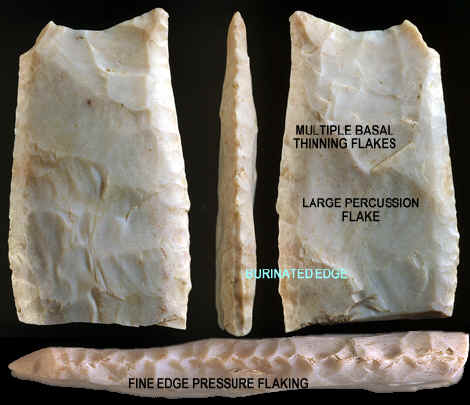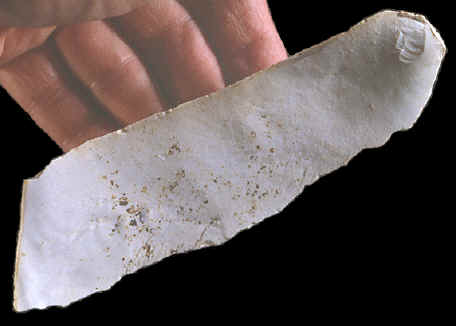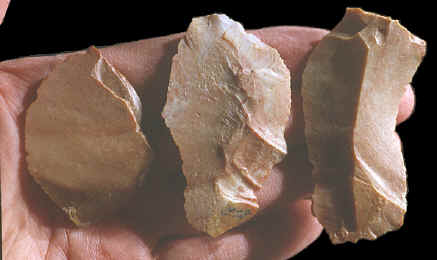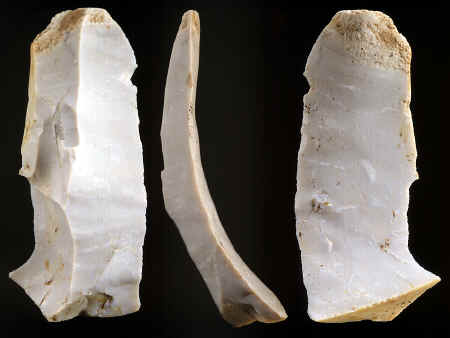|
PAGE
3 CONTINUED
FROM PAGE 2
McKINNIS
CLOVIS CACHE
CLOVIS
CULTURE
ST. LOUIS
CO., MISSOURI
12,000 TO
14,000 EST. YEARS AGO
PAGE 3 OF 3 PAGES
COPYRIGHT
DECEMBER 31, 2004 PETER A. BOSTROM

CLICK ON
PICTURE FOR LARGE TRIPLE IMAGE
BASE
OF A CLOVIS POINT
FOUND NEAR McKINNIS CLOVIS CACHE
ST.
LOUIS COUNTY, MISSOURI
DONNIE McKINNIS COLLECTION
This Clovis point was found approximately 100 feet from the
McKinnis Clovis cache. It is the only other Clovis artifact that
was reported from this site. It has multiple basal thinning
flakes, one very large percussion flake removal and a portion of
one edge has a burin flake removal. One of the edges also has
particularly well done pressure flaking that is actually similar
to some Folsom point edges. This point is made of Burlington chert
and it measures 2 1/4 inches (5.6 cm) long, 1 1/4 inches (3.2 cm)
wide and 1/4 of an inch (6 mm) thick. |
|
|
The eleven bifaces range in size from 5 5/8 inches (14.3
cm) long for the longest and 3 3/4 inches (9.5 cm) long for the smallest.
The widest biface measures 3 1/16 inches (7.7 cm) wide. The widest
percussion flake measures 2 1/2 inches (6.3 cm) wide.
|
|

CLICK ON
PICTURE FOR LARGE TRIPLE IMAGE
CORE BLADE
PRIMARY
CORE TRIMMING FLAKE
McKINNIS CLOVIS CACHE
ST. LOUIS COUNTY, MISSOURI
DONNIE McKINNIS COLLECTION
This is a primary core trimming
flake and it is the largest core blade in the McKinnis Clovis cache.
Primary core trimming flakes represent the initial core reduction
process. They are the first flakes that are struck off of a core. Primary
flakes are the largest flakes that are removed from a core and they have
outer cortex on the dorsal surface. This blade is made of Burlington
chert and it measures 5 1/4
inches (13.3 cm) long, 1 5/8 inches (4.1 cm) wide and 5/8 of an inch (1.5
cm) thick. |
|
|
Caches of Clovis artifacts are rare. They are almost always found on construction sites or in cultivated fields, by the general public. Only later
are they reported to archaeologists. Sometimes, these find sites can be
scientifically verified. The
Wenatchee site in Washington is one of the most successfully
excavated Clovis caches. In that case, archaeologists were notified early
and the majority of the artifacts were scientifically excavated. The
Drake
cache in Colorado is another example of a cache that was verified
scientifically by archaeologists who were able to return to the find site
and excavate additional Clovis related artifacts.
The cache illustrated in this article represents a typical find situation.
It was discovered during an
earth moving operation by an amateur artifact collector who was monitoring
the site for any stone tools that might be brought to the surface. The cache
was originally thought to be an Archaic cache. Only recently was it
suggested to the finder and owner, by two flintknapping friends, Marty
Rueter and Tim Dillard, that it might be Clovis related.
|
|

CORE BLADES
McKINNIS CLOVIS CACHE
ST. LOUIS COUNTY, MISSOURI
DONNIE McKINNIS COLLECTION
Twenty of the artifacts in the McKinnis cache were made from white
Burlington chert. The three flakes illustrated in this picture represent the only colorful chert in the cache.
These three colorful orange flakes
have not been positively identified. Donnie McKinnis, who is the discoverer
of the cache, says he has collected tons of raw chert
from this area but has
not seen this variety of chert locally. The blade on the right is the best
example. It was struck from a prepared core and it represents a secondary core trimming
flake. It has one dorsal ridge that was formed from two previous flake
removals. The other two flakes are the smallest of the 12 blades in the
cache. They could actually be bifacial reduction flakes rather than
flakes that were struck from a prepared core. The largest core blade
on the right measures 2 3/4 inches (7 cm) long, 1 1/4 inches (3.2
cm) wide and 3/8 of an inch (9 mm) thick.
Archaeologist Brad Koldehoff has commented that
the three orange colored flakes in this cache could be made of
Payson chert. The source for this material is approximately 100
miles north of the McKinnis cache site. Payson chert is also
reported by another archaeologist, Juliet E. Morrow, from the
Bostrom Clovis site which is located 30 miles southeast of the McKinnis
cache site. |
|
|
A large percentage of Clovis caches were covered with red
ochre. They seem to suggest some type of a ritual
involvement, such as offerings placed with a burial. But the Mckinnis
cache does not have any red ochre applied to the artifact surfaces.------It
would be easy to see on the white Burlington chert. It might be argued that
since the cache is not stained with red ochre that it was made for mundane purposes
and not related to
ritual use. It could be speculated that the cache was put away for later
retrieval. Maybe the individual couldn't carry it or maybe he
wanted some extra material cached away for later retrieval. Whither the
cache was originally placed with a burial and never intended to be retrieved
or placed as a cache in order to be used sometime in the future is
information
that will never be known.
|
|

CLICK ON
PICTURE FOR LARGE TRIPLE IMAGE
CORE BLADE
A SECONDARY CORE TRIMMING
FLAKE
McKINNIS CLOVIS CACHE
ST. LOUIS COUNTY, MISSOURI
DONNIE McKINNIS COLLECTION
This blade was struck from a prepared core and is classified as a
secondary core trimming flake. The only outer cortex is located on
the end of the blade. There is one dorsal ridge that was formed by
two previous blade removals. This blade has one of the most
pronounced curves as compared to the other blades in the cache. This
core blade is made of Burlington chert and it measures 2 7/8 inches
(7.3 cm) long, 1 1/2 inches (3.8 cm) wide and 9/16 of an inch (1.4
cm) thick. |
|
|
The study of
Clovis caches, along with experimental archaeology, may give
archaeologists new insights into the mechanical processes of Clovis
stone tool
making. One area of experimentation that might be suggested is the
rocker-punch
flaking technique. This process allows the knapper to apply a
large amount of energy to drive off very large flakes in different
directions across the biface. The technique uses less striking force if
compared to most of today's standard percussion flaking techniques using
copper and antler billets.
Although the McKinnis cache was not scientifically
excavated and proven absolutely to be Clovis related. The technology that
was used to make it will be its strongest case for a Clovis related cache.
The individual who made it was certainly very familiar with Clovis stone
tool making technology. This is a fascinating study collection that
should prove to be a positive contribution towards the study of Clovis
stone tool making.
|
|
"REFERENCES"
1912,
"Handbook Of American Indians North Of Mexico," pp. 178, 179.
1996, Morrow,
Juliet E., "The Organization of Early Paleoindian Lithic Technology
In The Confluence Region Of The Mississippi, Illinois and Missouri Rivers,"
p. 106.
1999, Boldurian, Anthony T. & Cotter, John L., "Clovis
Revisited, New Perspectives On paleoindian Adaptations From Blackwater
Draw, New Mexico," pp. 38, 39.
Personal communications with Donnie McKinnis.
Personal communications with Brad Koldehoff.
Personal communications with Richard Michael Gramly PhD.
|
|
HOME
ORDERING |



